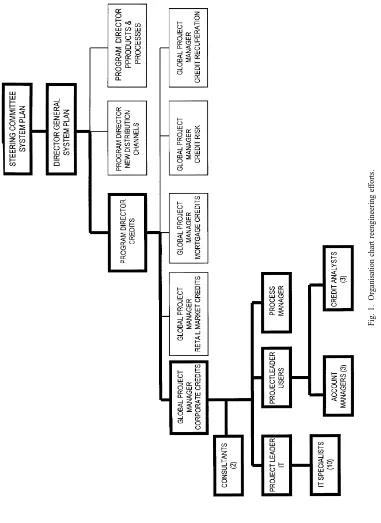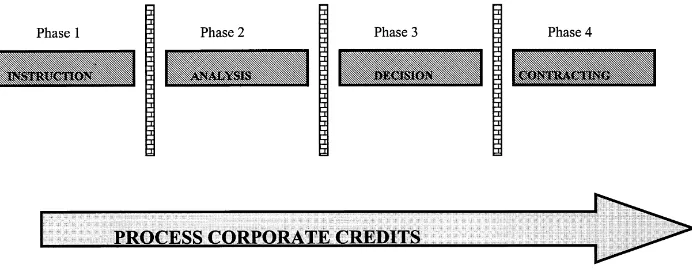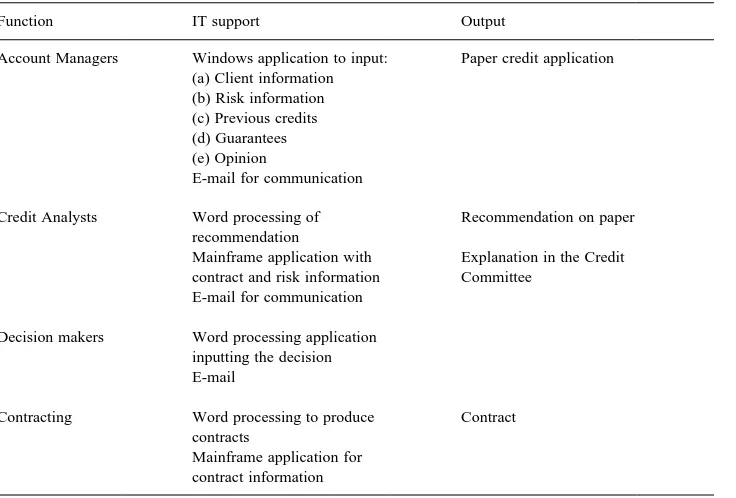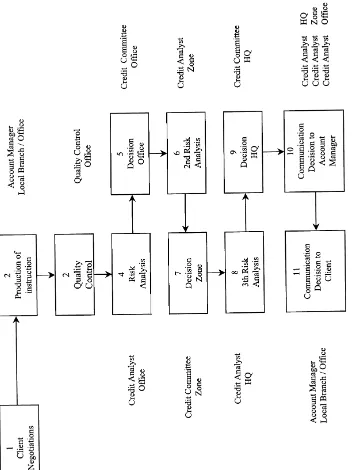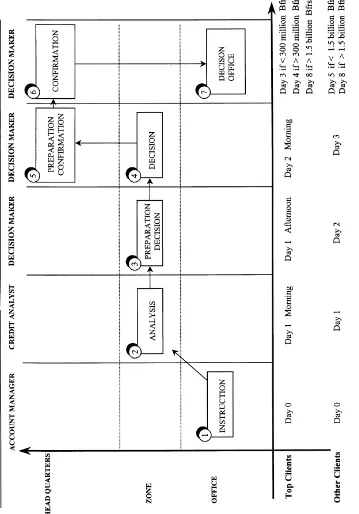W. Van Grembergen
*, J.-L. Van Belle
UFSIA, University of Antwerp, Prinsstraat 13, 2000 Antwerpen, Belgium
Received March 1998; revised paper accepted for publication by Professor R. O’Callaghan February 1999
Abstract
The Ge´ne´rale de Banque of Belgium has undertaken a number of major business reengineering projects (BPR) within their Strategic Systems Plan. In this article, the case of its Corporate Credit Project is described. The objective of this case analysis is to identify the why, what and how of this BPR project and to assess how successful it is. In addition, we examine how the findings are compared with the most important aspects arising from the BPR literature: process integration through information technology, empowerment of employees, the specific BPR project organisation, and typical BPR analysis (uncovering the pathologies of the old system and reengineering the old system taking into account the strategic limitations). The Ge´ne´rale considered this project a success with productivity gains as high as 25 and 30%, respectively.q1999 Elsevier Science B.V. All rights
reserved.
Keywords: Business process reengineering; Business performance; Information technology strategy; Information technology innovations
0963-8687/99/$ - see front matterq1999 Elsevier Science B.V. All rights reserved.
PII: S 0 9 6 3 - 8 6 8 7 ( 9 9 ) 0 0 0 1 4 - 1
* Corresponding author. Tel.: 132-3-220-40-74; fax: 132-3-220-47-99. E-mail address: [email protected] (W. Van Grembergen)
1Wim Van Grembergen is a Professor at the Business Faculty of UFSIA, University of Antwerp and is a guest
Professor at the University of Louvain (KUL). He teaches information systems at undergraduate and executive levels, and researches in business transformations through information technology, audit of information systems, and IT evaluation. Professor Van Grembergen is a member of the Standing Committee of the European Confer-ence on Information Systems (ECIS). He has published articles in journals such as the Journal of Corporate Transformation, EDP Auditing (Auerbach) and IS Audit & Control Journal. He also has several publications in leading Belgian and Dutch journals and, in 1997, published a book on business process reengineering in Belgian organisations and, in 1998, a book on the IT balanced scorecard. Until recently, he was the Director of the MBA Program and presently he is the coordinator of a professional two-year program on IT-audit.
2
1. Introduction
The concept of business process reengineering (BPR) has received considerable academic attention with many case studies describing successful BPR projects. However, most of these cases are US-based, including the IBM Credit Corporation and Ford Motor Company (Hammer and Champy, 1993), and the revisited American Hospital supply Corporation (Baxter) case described in Short and Venkatraman (1992). In the mid-1990s, BPR concepts were also introduced in Europe. Currently in Belgium, many compa-nies and government agencies (see Van Belle and Van Grembergen, 1997) are launching BPR projects. In this article, we consider the integration of the Corporate Credits process through information technology (IT) of the Ge´ne´rale de Banque of Belgium.
2. Company and sector background
Table 1 gives some key figures of three leading banks in Belgium. These figures reveal that, at the end of 1997, the Ge´ne´rale de Banque was by far the largest bank in Belgium with a balance total of nearly 6000 billion Belgian francs (approximately US$160 billion) which is more than 40% higher than the nearest competitor. Its leadership was confirmed by the level of its deposits, credits, interest return, and commission return from investment funds. In absolute figures, the profit of the Ge´ne´rale de Banque was also greatest. However, in relative terms, the Banque was less profitable than the Kredietbank, because of the relatively high ratio of cost/return. During the presentation of the 1997 results, Fred Chaffart, chairman of the Management Committee of the Ge´ne´rale, declared that one of the main objectives for the coming years was to decrease the cost ratio to 55%, a level which the Kredietbank has almost reached.
As with most other major Belgian banks, the Ge´ne´rale de Banque was characterised by a three-level structure: the Office, the Zone and the Head Quarters. The Office was the smallest entity and comprised a number of Local Branches. The Zone coordinated a number of offices. Head Quarters in Brussels provided centralised decision-making. Table 1
Key financial figures of major Belgian banks in 1997 (in billion Belgian francs). Source: De Standaard, March 14–15, 1998
Ge´ne´rale de Banque Kredietbank Banque Bruxelles Lambert
Balance total 5913 4168 4134
Deposits 3497 2250 2026
Credits 2242 1393 1629
Return 143.2 88.2 93.9
Interest 83.1 54.9 55.1
Commission 32.8 16.5 20.1
Profit 17.1 14.7 11.8
Cost/return (%) 60.3 56.7 62.4
bank. This led to a number of “process-oriented”, IT-enabled, organisational change projects. In fact, his all-embracing Systems Plan was the father of the many change projects undertaken in the Bank.
3.1. The systems plan
Developed in 1992–1993, the Systems Plan showed a need for redesigning some of the major business processes of the Ge´ne´rale de Banque. It was also the beginning of the various change projects such as the Corporate Credit Project, which is the subject of this article. The Systems Plan comprised two large infrastructure projects: the complete remake of the accounting system and the replacement of dumb terminals by intelligent workstation in the local branches. The Plan also defined the following three priority domains:
Credits
An international benchmarking study performed by a consulting organisation showed that the credit processes at the Ge´ne´rale de Banque were very labour intensive and therefore suitable candidates for reengineering.
New distribution channels
The development of new and IT-based distribution channels such as electronic banking for businesses and the retail market was perceived as an absolute priority for the Bank.
Products and processes
This priority implied the further optimisation of stock management and payment systems.
3.2. Project organisation
The organisation chart of the engineering efforts is shown in Fig. 1. President Chaffart and two other members of the Management Committee, Mr Verdickt (responsible for new processes and information systems) and Mr Dirckx (responsible for Commercial Credits) were the leaders of the Systems Plan and the reengineering projects. They “authorised and motivated the overall engineering efforts” (Hammer and Champy, 1993). Mr Dirckx was also the chairman of the Steering Committee of the Credits Project.
The operational leader of the Plan was the Director, General Systems Plan assisted by three Program Directors responsible for the different priority domains. Mr De Gols was in charge of the Credits domain. For each of the projects (e.g. Corporate Credits), a global project manager (Mr Vuerings) was appointed and a project team organised. The project or reengineering team consisted of:
• a process manager (Mr Morren for the Corporate Credits project); • a project leader IT;
• a project leader of users; and
• the users: people directly involved in the process.
Another important role in a BPR project is the process owner, defined by Hammer and Champy (1993) as “a manager with responsibility for a specific process and reengineering effort focused on it”. Within the Corporate Credit project, this role was shared between the project leader of users and the process manager. The project leader of the users managed the account managers and the credit analysts, both of whom were participants in the reengineering exercise while still being involved in the operation of the existing system. The process manager has a somewhat atypical role. He has a thorough knowledge of the credit processes but is not operational anymore. The reason for this rather complex project structure is that the process manager, as a non-operational member of the project team, is believed to be able to redesign the operations more freely.
The most important individuals involved in the Corporate Credits project, which reen-gineers the granting of credits for primarily small and medium enterprises, are the account managers and the credit analysts. The account managers close the deals and the analysts analyse the credit risk and finally issue the credit.
The Corporate Credit project was the most developed project at the time of writing this paper (1998): the reengineered system had already been implemented in one of the most important zones of the Bank. The other zones were to follow in due course. The other reengineering projects—Retail Market Credits and Mortgage Loans—had not yet become fully operational, although there were already some pilot implementations. Mortgage loans were being accommodated in a separate project because of their specificity. Tests on the new network technology and the workflow management software were performed in a Mortgage Loans pilot project and not in the Corporate Credits project. The Credit
Risk project is somewhat special because it is a research and analysis project regarding risk
management for the Bank as a whole.
Fig.
1.
Orga
nisation
chart
reengineering
ef
Fi
g.
2.
Time
scheme
of
the
Co
rporate
Credit
pr
4. The old process and key problems
Traditionally, the process of granting corporate credits consisted of four phases (Fig. 3):
1. the instruction phase performed by the account manager resulting in the credit file; 2. the analysis of the file by the credit analysts;
3. the decision taken by the authorised Credit Committee; and 4. contracting: the juridical and administrative settlement.
Analysis of the existing process revealed several pathologies or dysfunctions for speci-fic phases and/or for all the phases.
4.1. Inadequate document integration
The credit file was to a large extent a paper file which included:
• the credit application;
• a document with the formal decision;
• a copy of the client’s other credit agreements; • balance sheets, and
• internal correspondence and exchanges of letters with the client.
Of course, the different participants in the Corporate Credit process had some IT support; but, as Table 2 shows, the supporting information systems were merely functional systems and were certainly not integrated. The participants had their own separate systems that consisted primarily of simple databases, word processing applications and e-mail. Thus, the output of their work was in the form of paper-based documents.
This paper file and the lack of integration of the information systems resulted in a time-consuming communication of data between the different parties involved especially among the account managers, credit analysts and credit committee. Moreover, each process participant had their own version of the file, often with different data. As a consequence, decisions were often based on conflicting information.
4.2. Much rework in the analysis phase
Depending on the size (amount of loan) and the complexity of the file, it was sometimes analysed by three credit analysts at different levels. Each of these analysts produced their own synthesis document giving their opinion. For each level, the report was made by replicating and by retyping data from previous credit reports. Fig. 4 illustrates this rather complex process.
4.3. Inadequate functional integration
The credit exposure of the client and the district, rather than the industry or sector, were relevant in assigning credit files to analysts, so that analysts had to cope with heteroge-neous files often from different sectors. This sometimes resulted in conflicts between the account managers and the analysts when an account manager had more expertise (or thought they had) for a specific sector. The regional division also led to arbitrary regional differences in the analysis and evaluation of the credit files. Moreover, benchmarking with similar credit applications was not possible. The lack of functional integration was also the reason why in many cases the account manager disagreed with the decision taken by the analyst. The reason for this was that the account managers were generalists and more commercially oriented than the analysts. They had a much more thorough knowledge of Table 2
IT support before BPR
Function IT support Output
Fig.
4.
Process
ing
of
large
credit
application
(existing
proc
the credit policy and considered each case with this policy and other similar applications in mind.
5. The reengineering effort
In exploring an alternative design for the old corporate credit process, the only limita-tion was the so-called Credit Charter of the Bank. This stipulated some important prin-ciples. The BPR team members were bound by this Charter and it offered them a framework that ruled the redesign of the existing functional organisation and old business rules.
The two most important principles of the Charter were:
The principal division between instruction and analysis. Contrary to the common
prac-tice in Anglo-Saxon countries, Continental European banks still stick to the principle of dual responsibility: the account manager’s evaluation and decision has to be confirmed by the analyst. Of course, this procedure increases the cycle time but at the same time decreases the credit risk. Hence, the internal rule of dual responsibility was not challenged. (The dual responsibility maybe one of the reasons why the Belgian banks score extremely well with regard to the depreciation due to credit failures.)
The connection of the decision authority with the person and not with the function. This
principle means that in the organisation of the Ge´ne´rale de Banque, functions are not primary but competencies are. A person X, replacing a person Y in a function A, will never be given the authority of Y automatically; the authority of X will be determined again on the basis of X’s competence and experience.
Taking into account these Charter principles and using primarily the BPR principles as described in Hammer and Champy (1993), the following redesigned corporate credit process was developed by the Bank:
• one single electronic file;
• as much functional integration as possible;
• reduction of analysis levels (from three to one); and • empowerment of the actors involved.
5.1. Single electronic file
and small businesses are more sensitive to new market trends and identify market signals much faster. This is illustrated by the kind of projects they propose. This information proved to be very interesting for larger credit applications. Fig. 5 illustrates the new process for large applications. For smaller credit applications, shorter flows were imple-mented. Although their analysis was also done in the Zone by the “reengineered” credit analysts, the ultimate decision was taken by the Zone or at the Office level, depending on the amount of the loan. This is an illustration of the BPR principle that processes may have multiple versions, and hence must be handled differently (Hammer and Champy, 1993). Credit analysts now work in a team which results in greater synergy and much more balanced evaluations and decisions. Now, 19 credit analysts are working in the Zone and in smaller groups (case management teams in terms of Hammer and Champy (1993)) of four or five people who are responsible for a sector or different sectors. This more inten-sive formal and informal communication and interaction between the analysts, together with their sectorial specialisation, has increased the quality of decision making.
5.3. Empowerment
The relationship between the account manager and the credit analyst became more of a partnership as a result. This is even made concrete through an effective rotation policy. A mere commercial career is not possible anymore in the Bank; account managers also have to be analysts for a certain period in their career and vice versa.
The final decision is still taken by the authorised Credit Committee (Office, Zone or Head Quarters), but it is mostly a confirmation of the agreement between the analyst and the account manager. Moreover, the account manager and the analyst are responsible for the follow-up. The Credit Committees now have more time to concentrate on their real job: the evaluation of complex and high risk applications, the commercial aspects, pricing credits and the general credit policy.
6. The effectiveness and benefits of the organisational overhaul
Fi
g.
5.
Process
ing
large
credit
applicat
ions
(the
new
one analysis at Zone level) and that the files are now transferred electronically instead of being transported physically to and from the Office, Zone and Head Quarters.
A major reason for the reduction of the cycle time is the creation of the electronic files. The cycle times could be shortened even more once the Commission Bancaire accepts the electronic files and the electronic signatures become legally acceptable.
6.2. Productivity
The results of the project were immediately noticeable: the relations between the account managers and the credit analysts improved noticeably and the differences of opinion decreased dramatically. As a consequence of this, the number of appeals, an account manager can always lodge an appeal if a credit analyst were to give a negative opinion, also decreased. This reduction of appeals was an important operational objective of the project. The more quantitative results are discussed in the following paragraphs.
A productivity gain of about 5% was reported for the account managers. This gain in time did not result in effective personnel savings but instead was converted into commer-cial time and, eventually, greater availability for clients.
Productivity gains are most likely to be found in the analysis phase. Actually, a decrease in the headcount of 15% (three full-time equivalents) was achieved. By the same token, the reduced staff are nevertheless coping with a higher volume of work: they analyse an increased number of credit files and invest more time in gathering more relevant informa-tion in order to make qualitatively better decision. These benefits were realised primarily because of the online access of all credit files and other credit information and the reuse of data in different output documents. It is already obvious that within a short time, the objective of a productivity gain of 25% (six full-time equivalents) will be reached taking into account the learning effect of the first months and the increased volume of work that can be achieved with fewer people. At the time of writing, the effective process time of an average credit file decreased by approximately one hour.
gain of 30% (or approximately one hour a day for the members of the committee and two hours for the Credit Directors). These savings were not expected to lead to a reduction in headcount, but were to be invested in more time for customers and in coaching their team.
6.3. Risk management
The quality of the delivered credit analysis reports improved. This is certainly influ-enced by the new partnership between the account managers and credit analysts, the centralisation of the best analysts at the Zone-level, and the industry specialisation of the analysts. Moreover, the workflow management software managed and coordinated the new process in a way that the required sub-processes were performed in the correct sequence and the most risky files were given priority. Of course, the positive effect of this better risk management could only be measured over time.
6.4. Costs
The realisation of the Corporate Credit project took 18 months. During the lifetime of the project, 10 people were involved full-time. The training programme included three days for the account managers, four days for the analysts, two days for the other credit workers, and one day for the decision makers.
The additional hardware and software costs (scanners, jukebox with optical disks, servers, etc.) amounted to 20 million Belgian Francs (approximately US$550 000) per Zone (100–150 users). Compared to the standard workstation used in the Bank, the work-stations supporting the Corporate Credit process needed additional hardware (special screens) and a software licence, which together amounted to an investment of 100 000 Belgian Francs (approximately US$2800). The renewal and upgrade of the network was a necessary infrastructure investment for the Bank that had already been planned and had been brought forward by this project.
7. Change management considerations
Although initially the Human Resources Department had not been involved in the Systems Plan and the reengineering projects, it turned out that this was really necessary: not only is Information Technology an enabler, but also human resources is (see e.g. Van Grembergen et al., 1997). However, in the beginning, it was assumed that the technology was the only constraint. The transfer speed of the imaging information was too slow with response times of four and even five seconds. These problems could be “easily” overcome by installing more powerful systems. For some users, this technology push was very difficult to digest, as illustrated by a comment of one of the Zone Credit Directors: “For many years, we have lived on bread and water (regarding IT infrastructure) and now we get indigestion from what is installed and what is to come…”.
dramatic for the decision makers. They had problems, in particular, in adapting to the new style of making decisions on the basis of a written analyst’s report rather than on the basis of an explanation given by the credit analyst in the Credit Committee. It is obvious that in the case of such fundamental changes as these, one has to go through a learning process and participants need to remain motivated especially in the start-up phase of the project. In addition, new human resource challenges emerge. The top and operational level of the Bank were very enthusiastic about the project and supported it from the beginning. However, problems arose with the middle management because of the decreased impor-tance of their traditional role. The contracting phase was soon to be reengineered as, currently, analysts and contracting employees do not share workplaces anymore at the Office-level and this causes communication and coordination difficulties. Integration of case management teams has to be achieved, consisting of analysts and contracting employ-ees at the Zone level. This may be very difficult to bring about because most of the contracting people are part time employees with a lower educational level and this will make empowerment more difficult. Moreover, they are not so mobile or are less willing to commute every day to the Zone.
Further, it is clear that implementing organisational changes will be an ongoing activity within the Bank. As indicated earlier, the reengineering of the contracting process was already planned. Even during our interviews with the key people concerned with the credit processes, a new quite fundamental idea emerged: why is it that one event (an individual credit application) must lead to one analysis and one decision? A differentiated project cycle whereby one analysis can be reused for two or even more credit decisions for an individual company could result in more savings and a greater decrease of the cycle time.
8. Lessons learned
8.1. Lesson 1: choose the right processes
The Corporate Credit project was embedded in the Systems Plan of the Ge´ne´rale. The motivation for this project was that benchmarking showed it to be a very labour intensive process, and hence suitable for reengineering. It was never questioned in any fundamental sense whether it was the right process to reengineer. In his book, The Process Edge, Keen (1997) defines the process paradox. He illustrates this paradox with the well-known BPR case of Mutual Benefit (Hammer, 1990) in which they reengineered successfully their insurance issuance process but fell afterwards into insolvency. Clearly, the wrong process was reengineered in this instance.
As we hoped, this article shows the Corporate Credit project to be a success for the bank in terms of reduced cycle time, increased productivity and improved quality of risk analysis. When explicitly asked, Ge´ne´rale de Banque stated that it was the right process to reengineer because “the payback period is approximately two years, not even taking into account the more intangible benefits such as an improvement of the quality of the risk management and the positive result of a better client service”.
The crucial question, however, still is how this project (redesigning the credit process) affected the Ge´ne´rale’s business and whether, consequently, they reengineered the right process. The search for the right project can be done with the Salience/Worth Matrix developed by Keen (1997). This matrix shows the importance of the business processes to the enterprise (Salience) and whether it increases or decreases the value (Worth). It is clear that what are called Identity Processes (which differentiate a firm from its com-petitors) are the appropriate candidates for reengineering and are an asset to the company. Thus, a crucial question for the Ge´ne´rale is to assess whether or not Corporate Credit was one such process.
8.2. Lesson 2: challenge the limitations
Hammer and Champy (1993) conclude that processes often suffer from division of labour and old business rules, and that, therefore, a clean slate approach is needed. The Credit Charter, with its principal division between instruction and analysis, was never really challenged during the BPR exercises. The Ge´ne´rale was not yet ready to change its culture and ditch the principle of dual responsibility. The question—can responsibility be replaced by IT measures, without losing control?—was never raised. From the beginning of the project, the Credit Charter was seen as a limitation to the BPR exercise. As explained earlier, the argument was that this is necessary in order to cope optimally with credit risks.
8.3. Lesson 3: go for radical redesign and dramatic improvements
8.4. Lesson 4: consider the new human architecture
In the BPR literature, it is often stated that human resources are important enablers within a BPR project. Davenport (1993) refers to it as “organisational and human resource enablers of process change”. The Ge´ne´rale’s Corporate Credit process again demonstrated that the design of a new human architecture was of considerable importance and a neces-sary condition for success. But, as observed in other Belgian BPR cases, there was no real involvement of the HRM department at the beginning of the project. They were only involved when rumours began to circulate about the ongoing BPR projects. This problem was tackled by a plenary session for all participants of the process. This was certainly a good way of responding to the problem, but still, the new human architecture is yet to be clearly developed. Following Kettinger et al. (1995), “a redefinition of job titles and positions affected by changes in cross functional processes” and “incentives and reward structures based on group performance and an individual’s team contribution” have to be incorporated. Developing a new human resource architecture was also a crucial but very difficult issue within the BPR project of Ge´ne´rale.
8.5. Lesson 5: consider the new IT architecture
The enabling technology was imaging and workflow management software, implement-ing these new technologies was no real problem, but reengineerimplement-ing the existimplement-ing and old computer network appeared to be a serious and underestimated problem. This differs from the opinion often expressed that technological issues are more easy to solve than human resource challenges in the sense that more adequate technology can always be purchased. In the case of Ge´ne´rale, the technological problems substantially did delay the project.
9. Conclusions
In this case we have attempted to discuss the why, what, and how of the Corporate Credits BPR project as carried out within the Ge´ne´rale de Banque of Belgium.
processes. There was also a focus on internal efficiency and on doing more work with fewer people in order to improve the relatively high cost/return ratio.
The reengineering effort resulted in a single electronic file that integrated all the docu-ments and data, and allowed the account managers, the credit analysts and the decision makers to read and change the credit file simultaneously. This was technically implemen-ted through workflow management software, imaging technology, and a new computer network. The flow of the new process increased the cycle time substantially. In the old system, credit files were analysed at three levels; the Office, the Zone and the Head Quarters. In the new credit process, each file was only analysed at the Zone-level and the credit process now has multiple versions; small applications can be decided by the Zone, or even by the Office. This process integration is not, however, the end of the project; the next phase is the integration of the contracting people, which will undoubtedly be more difficult to carry out.
The project organisation was somewhat complex, but seems to be a somewhat classical organisational structure for a BPR project. A rather atypical role is, however, the process manager who is a non-operational member of the project team with a thorough knowledge of the credit processes. As he was not operationally involved, he had no personal stake in the process and could reengineer more freely.
The Ge´ne´rale de Banque considered the Corporate Credit project as being successful, arguing that the payback period of two years was a good result. Further, it was felt that this BPR project had had a positive impact on the business and provided added value for the clients. The benefits for the clients were:
• faster responses to credit applications;
• qualitatively better decisions with a clear indication as to why it might be better for the client not to undertake the project; and
• proposed alternative credit means more appropriate for the client project.
Finally, it can be argued that this case illustrates all the key elements of a BPR project as advocated in the BPR literature such as process integration through information technol-ogy, empowerment of employees, project specific organisation, and process analysis (to uncover the pathologies of the old system). The reengineering effort, however, cannot be considered as a 100% “clean slate” implementation. The approach was based on a redesign of the old process incorporating the possibilities afforded by the new IT architecture in order to achieve the stated performance improvement objectives.
Acknowledgements
Management Review Fall, 7–21.
Southern, G., 1994. Introducing BPR: a brainstorming approach. Business Change and Reengineering, The Journal of Corporate Transformation Summer, 39–47.
Van Belle, J-L., Van Grembergen, W., 1997. BPR through IT in government: re-engineering the payroll admin-istration for Belgian teachers. Knowledge and Process Management, The Journal of Corporate Transforma-tion March, 11–21.

